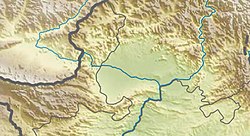| Kalawan | |
|---|---|
 Copper-plate inscription mentioning the
Sarvastivadas, in the year 134 of the
Azes era, i.e. 84 CE, Kalawan,
Taxila.
[1]
[2] | |
| Religion | |
| Affiliation | Buddhism |
| Region | Gandhara |
| Ecclesiastical or organizational status | Stupa and vihara ruins |
| Year consecrated | 2nd century CE |
| Status | Artifacts removed |
| Location | |
| Location | Pakistan |
| Geographic coordinates | 33°43′40″N 72°51′11″E / 33.727835°N 72.853069°E |
Kalawan (originally meaning "The caves") is the name of an archaeological site in the area of Taxila in Pakistan, where it is one of the largest Buddhist establishment. [3] It is located about 2 km from the Dharmarajika stupa. [4]
Kalawan has a vihara monastery, which is the largest in northern India. An inscription, recording the enshrinement of relics as a gift to the Sarvastivadin School, was found in a chaitya hall mentioning the date of "the 134th year of Azes," which corresponds to 77 CE. [5]
Small stupas were found inside the monasteries. [6] The Kalawan monastery, together with the Dharmarajika display an original kind of architectural arrangement in which an image shrine is built opposite the entrance. [7] It is thought that this architectural pattern was initiated in the northwest and then became the prototype for the later development of monasteries with shrines in Devnimori, Ajanta, Aurangabad, Ellora, Nalanda, Ratnagiri and others. [7] [8]
References
- ^ Sastri, Hirananda (1931). Epigraphia Indica vol.21. p. 259.
- ^ Marshall, John (2013). A Guide to Taxila. Cambridge University Press. p. 134. ISBN 978-1-107-61544-1.
- ^ Khan, Muhammad Ishtiaq (2000). World heritage: sites in Pakistan. UNESCO. p. 29.
- ^ Marshall, John (2013). A Guide to Taxila. Cambridge University Press. p. 129ff. ISBN 9781107615441.
- ^ Hirakawa, Akira (1993). A History of Indian Buddhism: From Śākyamuni to Early Mahāyāna. Motilal Banarsidass. p. 233. ISBN 9788120809550.
- ^ Schopen, Gregory (1997). Bones, Stones, and Buddhist Monks: Collected Papers on the Archaeology, Epigraphy, and Texts of Monastic Buddhism in India. University of Hawaii Press. p. 185. ISBN 9780824818708.
- ^ a b Behrendt, Kurt A. (2004). Handbuch der Orientalistik. BRILL. p. 170. ISBN 9004135952.
- ^ Behrendt, Kurt A. (2004). Handbuch der Orientalistik. BRILL. p. 171. ISBN 9004135952.

